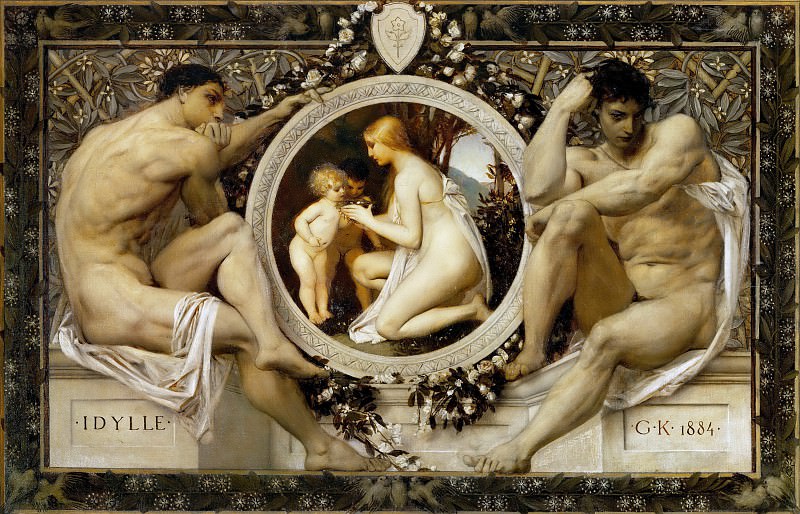Idylle Gustav Klimt (1862-1918)
Gustav Klimt – Idylle
Edit attribution
Download full size: 3800×2437 px (4,6 Mb)
Painter: Gustav Klimt
Location: Wien Museum, Vienna (Wien Museum Karlsplatz, Museen der Stadt Wien).
Klimt’s paintings are deeply symbolic--they are hard to read at a glance, you have to ponder, speculate, hypothesize, and reject them. And the most fascinating thing about them is that there is no single clue that suits everyone. Everyone is free to interpret them the way he wants, depending on his worldview and outlook on life. After all, everyone has different priorities and a different way of perceiving reality. So "Idyllia" can hardly seem truly idyllic to anyone.
Description of Gustav Klimt’s painting Idyllia
Klimt’s paintings are deeply symbolic--they are hard to read at a glance, you have to ponder, speculate, hypothesize, and reject them. And the most fascinating thing about them is that there is no single clue that suits everyone. Everyone is free to interpret them the way he wants, depending on his worldview and outlook on life. After all, everyone has different priorities and a different way of perceiving reality.
So "Idyllia" can hardly seem truly idyllic to anyone. At the center of the picture is a mother caressing her children, a scene that is sweet and chaste and pleasing to the eye. It celebrates life, the eternal rebirth and continuity, happiness, peace and joy of motherhood.
The woman is gentle, the children curiously bow their curly heads to her. But there is anxiety and twilight around this sweet scene. This is shown even in the chosen palette and brightness of colors - in the center of the picture they are warm, splashing colors and create an extremely pleasant impression. On the contrary, the colors are muted, faded, dark tones prevail around the edges.
The two young men look at the mother and children expectantly and sadly. It is as if they are waiting for everything to break down, to fly into hell and stay there. At the same time, they sit on the stones, reminiscent of the gravestones, and the flowers, in which the middle circle of the picture rests, look like bouquets that are brought to the tombs in memory of the dead. And then everyone is free to interpret it as he likes.
One will see death, which is forever waiting for life to yield to it and allow it to take both mother and children, and the flowers laid on their tombstones. Some say that outside the family there is only ashes and a lack of life and meaning. Some will not think of such lofty matters at all and will simply marvel at the way the children play with their mother.
That’s what the creator wanted - for different people to interpret in their own way and for everyone to find something different in his picture.
Кому понравилось
Пожалуйста, подождите
На эту операцию может потребоваться несколько секунд.
Информация появится в новом окне,
если открытие новых окон не запрещено в настройках вашего браузера.
You need to login
Для работы с коллекциями – пожалуйста, войдите в аккаунт (open in new window).




















COMMENTS: 1 Ответы
Красиво все.
You cannot comment Why?
Flanking this central medallion are two large, muscular, nude male figures. They are seated, with their bodies contorted in pensive poses. The figure on the left leans forward, resting his chin on his hand and looking towards the central scene, his gaze thoughtful. The figure on the right leans back, his arm bent and his hand behind his head, projecting an air of contemplation. Both figures are draped with white cloth around their lower bodies.
The entire composition is framed by an elaborate border of dark, intricate foliage, interspersed with white flowers and small birds. The word IDYLLE is inscribed in the lower left, and the artists initials G.K. and the year 1884 are in the lower right. A crest with a floral emblem is positioned at the top center, above the circular frame.
The subtexts in Idylle likely relate to themes of nature, innocence, beauty, and contemplation. The pastoral scene within the frame evokes an idealized vision of life, possibly representing purity and the simple joys of childhood. The powerful, sculpted male figures on either side could symbolize humanity observing or contemplating this idyllic scene, perhaps representing the intellect or the masculine principle contrasting with the nurturing feminine and innocent childhood within the circle. Their pensive postures suggest a reflective attitude towards the displayed idyll. The ornate border can be interpreted as a representation of the civilized world or artistic framing that contains and presents this timeless, natural beauty. The overall effect is allegorical, suggesting a harmonious interplay or contrast between idealized nature and human thought.